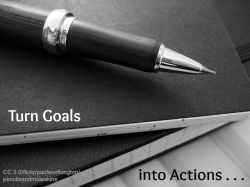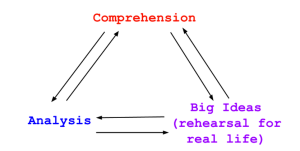Note: I originally wrote this post on my business blog over at Create Balance (http://www.createbalancedlife.com/iwillfight/). But I wanted to share it here as well.
I have never wanted to tell anyone how to live their lives, where spend their time or what they values should be. I’ve never had the goal of telling anyone WHAT to do. But one of my missions is to help moms and dads live their values out day-to-day and to be the parents and people they want to be. I’ve seen how systems help us get some control over parts our lives, which is huge when so much feels out of our control.
Now is one of those times when I’m feeling that lack of control acutely. And I’m scared as hell, not just for myself, but for my kids, my friends, my family, and my loved ones.
I would never suggest that I have the answers for exactly how deal with this. But we all have to deal with it.
We all had to get up on Wednesday morning and explain to our kids what happened. We all have to put one foot in front of the other, even when we want to just curl up into a ball under our covers. For me, taking that action starts with my most basic of systems. Because, especially in the face of fear and anger and despair, I have felt the power of retreating to a system to guide me through the darkness.
Here is the system I’ve used to fight through every hard time I’ve encountered:
- I start inward. I focus on my feelings, my thoughts, and I process those.
- I connect closely. I connect with my loved ones, my friends, the people who are supportive. Yes, this means I’m in my “bubble.” But I need the support of my bubble before I do anything else.
- I build outward. I embrace the two biggest weapons in the fight against despair: TRUTH and ACTION.
Here is what it looks like after a devastating result for my country:
I’m starting inward. I’m crying and ranting and hugging friends. I’m saying “what the fuck” a lot and sharing my anger at the many people in our nation who are racist, misogynist, homophobic and hateful. My husband pointed out that some people voted for Trump not because of those things, but despite them. I pointed out that that kind of act is essential the definition of privilege – the ability to cause harm to so many people just so you could “make a point” to the powers at the top. I’m not holding back. I’m owning my anger and letting it fuel me.
I’m connecting closely with family. I’m focusing a bit more on my kids. I’m neglecting work and other responsibilities to play with them, read books to them, and snuggle with them more. I’m hugging them more. I’m letting their hope and joy give me inspiration. My husband and I are holding hands a bit more and comforting each other often. We are strengthening some of the glue that holds our family together now, and will continue to help us weather the storm: the glue of compassion, love, caring and kindness.
I’m connecting closely with community. I’m hugging friends. I’m meeting with other women in safe spaces to air our fear and sorrow so that we can go on to fight another day. I’m joining up with social media groups who are going to fight the hatred and attacks against our social safety net that are coming. I’m gearing up to throw down with the next Trump supporter I see in my town (because they are here). But I’m gearing up through connection and solidarity. I’m letting my anger fuel us all.
I’m taking action. I’m gearing up to fucking fight. I’m neglecting my work, but I’m drafting a letter to my congress people imploring them to fight the Republican house and senate with the exact same obstinate shutdown of government that the Republicans did for the last 8 years. Not as payback. We need to do this to protect ALL Americans: women who need healthcare (like me), my children who rely on state-run programs for social and emotional support, my family and friends who fear for their lives because of hate, racism, and homophobia, and for our children and us who are going to start to feel the significant effects of climate change and will now have a country that is less prepared to deal with those ramifications. So, my two senators and my representative are going to get that letter from me. And then I’m going to do what I can to push the Democratic National Committee to mobilize to get house and senate seats in 2018. Along the way, I’m going to donate as much money as possible to Planned Parenthood and the ACLU, both of which are already mobilizing to protect Americans against the onslaught of a hateful and unconstitutional Republican agenda.
DONATE TO PLANNED PARENTHOOD HERE
DONATE TO THE AMERICAN CIVIL LIBERTIES UNION HERE
I’m taking action. One day at a time.
Next week I’m going to be running a 6 day “Get Focused” challenge. You are invited to join the Create Balance Community in this challenge – we would love to welcome you into the fold. I planned this challenge out when I thought I would be looking at a different reality on November 9th. But, as I said to folks in my group last night, I think all of us moms and dads need these tools more than ever.
We have to get focused on what matters most to us and our families so that we can gear up for the fight ahead. We need to spend time on the things that matter most to us to fuel our hope and belief in the power of good to overcome evil. We need to.

Long-term instructional planning has always been a strong point in my teaching. The execution of that planning has been the area I’ve grown in the most, but I came into teaching with the skills in place to set long-term goals, and then decide on measurable action steps that would get my students there. If I could just do planning and have someone else do all the grading in my teaching, I would gladly do so. Planning the year, units, and even the day-to-day lessons is the place where I truly enter a state of flow. Time seems to stand still as I immerse myself in thinking critically about objectives, consider the reading, writing, and metacognitive skills necessary to meet those objectives, and plan the lessons and experiences that will lead my students to that learning.
I was recently reminded of the joy I find in this state of mind when I had two hours on a Wednesday just to sit and plan. I set my own schedule and timelines. I could follow new ideas or insights without worrying about the bell ringing and students flooding into my room. I emerged with a solid curriculum plan, but also a refreshed mind and a feeling of accomplishment and strength.
Then I thought “I wonder when my students feel this way?”
I know many of them experience this feeling of flow when playing sports, or creating art. Some feel it when playing video games, or writing their fan fiction.
I don’t know how many of them, if any, experience this feeling in school.
When I set up work time in my classroom, my goal is for each student to work at their own pace, in a way that works for them. Of course, part of this learning means they must figure out what actually works for them: when listening to music will help, and when it won’t, how to make to-do lists for themselves to maintain productivity, how to choose pre-writing options instead of simply filling out the worksheet that a teacher gives them, etc. Ultimately, through all the lessons, what I hope is that students achieve a sense of flow when reading and writing. I want them to get lost in a book and be shocked when the bell rings and independent reading time is over, instead of sighing with relief. I want them to get immersed in their writing and not realize that thirty minutes has flown by. I want them to do these things not just because I think it will make them a better reader or writer (since, frankly, for most of my students, simply more time spent reading and writing is likely to make them a better reader and writer) but also because I want them to experience the joy of “flow” with these academic tasks as much as with the other joyous activities they engage in their everyday lives.
Last week, during the end of a “work” day I announced it was time to wrap things up. One girl, for whom the writing assignment had finally clicked, had been hard at work. She lifted her head up and said “really? How is class over? That went by so fast.” Right then and there I wished to have double-blocks again (although my past-self was screaming “NO!! Remember what those were really like??”) Just so this student could have stayed lost in her writing. What I want to move towards is figuring out ways to give students more of this time, but not lose the time for the instruction that they need. This is harder to do without the conferencing options I had in my smaller classes but I want to move towards it, because, even in our imperfect school system with its arbitrary deadlines, bell ringing, and 20 minute lunches, students still deserve a chance to get lost in words and ideas.
When I first started teaching I taught five classes in a six period day. My class sized ranged from 25 to 40, and I would often have 40 kids on my roster, but no more than 35 show up on any given day (which made for problematic seat shuffling when I had less than 40 chairs). At first these classes felt packed to the gills. Kids had little personal space and it usually was a work of extreme yogic twisting to squeeze my way through desks to check work or help kids. But like most things, even difficult or borderline reprehensible things, I got used to it. The kids were used to it since their schooling had been like this for years. For me, became a way to “humble brag” to other teachers about your caseload of 160 students, or your class of 40 with children sitting on the widow sills.
Because I was new to teaching, I really didn’t know any better.
Fast forward a few years and I’m teaching in a small school in Boston. When I started at the school, one of its points of pride  was the small class sizes. My first two classes that I taught there were one of 15 kids and one of 8. It was amazing. Liberating. Sure, it took me a solid three months to adjust my teaching for it. The thing about big classes is that my tendency is to overscaffold the work since there are kids in the room who need the extra scaffold, and with 30+ kids I didn’t develop any good systems for making sure each kid was assessed properly and got the right scaffold for them for each assignment. So I used to scaffold the whole thing, often to the detriment of the kids who needed to be pushed in their reading and writing instead of needed another graphic organizer.
was the small class sizes. My first two classes that I taught there were one of 15 kids and one of 8. It was amazing. Liberating. Sure, it took me a solid three months to adjust my teaching for it. The thing about big classes is that my tendency is to overscaffold the work since there are kids in the room who need the extra scaffold, and with 30+ kids I didn’t develop any good systems for making sure each kid was assessed properly and got the right scaffold for them for each assignment. So I used to scaffold the whole thing, often to the detriment of the kids who needed to be pushed in their reading and writing instead of needed another graphic organizer.
I adapted to my smaller classes sizes, and in the process I’ve seen kids grow so much with that “Right In Time” instruction, where my conference with them happens once the ideas for writing have started to bloom,or just when the real confusion with the text has started. I watch the magic of providing the right tool or right modeling to the kid at the right time and having their writing blossom into something magnificent. I have no doubt that this magic can and will still happen in my classes of 31 this year. But I suspect it won’t happen as much considering there is literally less time to conference with each student. With more classroom management tools need to keep the volume level down during mini-lessons, I will need to turn to some scaffolds that I would not otherwise use for all the kids.
The students in my classes of 31 will learn, just like the students in my classes of 38 and 40 learned oh so many years ago. In fact, I suspect my current students will learn more both because of the effective structures of support in my school, and because I’m a more experienced and stronger teacher than I was ten years ago. But I’m afraid the struggling students won’t grow as much as my struggling students in my class of fifteen grew last year. I’m afraid the students who need to be pushed won’t be pushed as far as the students in my class of twenty were pushed last year. I’m afraid that it is easier for kids to hide out, to pretend they don’t need help when they do, or just for the loudest ones to get attention even more over the cacophony voices that happen in a class of 31, even when each child is talking at a reasonable level.
My co-teacher is a superhero, and she has figured out some ways to make sure we target the kids who need it the most with our conferences, and she is also doing a great job thinking ahead to about additional scaffolds our ELL students will need as the reading and writing becomes more complex. Having her plan some concrete strategies has helped mitigate my lamenting about how much more these kids could learn if they were in smaller classes. But I still feel some sadness when I don’t get around to conference with everyone in the span of a week, or I realize that a kid has been hiding to the side, being confused and unsure so, so quietly that it’s a day or two before I figure out that he needs me. I’ve read the studies that show that class size doesn’t matter much when measuring test scores. Maybe it doesn’t. But I can tell you it does affect my ability to connect to kids, to support individual growth, to give kids choice, to build confidence, and to do a host of other things that don’t always show up on these tests. And that makes me fee bad for my kids from ten years ago, and the kids in my classes of 31 now.

Social media has its problems. There is FOMO (Fear of Missing Out). There is the time-suck when a quick “check” turns into a 30 minute-long browse. There is the envy of seeing beautiful vacation pictures while you are buried in 5 feet of snow.
I’ve often thought about deleting my social media accounts, if only to keep me away from those toxins. But I can’t bring myself to in large part because of all the benefits of social media. Unlike what John Kasich would have you believe teachers don’t have a lot of time to sit around and chat in a teacher’s lounge. We teach full loads, grade papers, run in and out of meetings, and grab a bite to eat or get a chance to pee when we are lucky. Time for collaboration or collegial relationships are slim, especially when you have children of your own to get home to at the end of the day.
So I’m grateful to live in a time of social media when I can still get the benefits of working with other teachers, but virtually, and often my kids go to bed. Read more…

Remember June? Oh, it seems so long ago. You were comfortable enough with your students that you could let jokes (and maybe even a hint of sarcasm) sneak into your room. It was all about final units, final exams, end-of-the-year celebrations, etc. When June rolled to a close maybe you were focused intently on your summer travel plans, or packing up your room. Maybe you were thinking about ideas for September. Maybe you were thinking about the things you wanted to do differently next year, the lessons you learned, the ways you could improve this writing assignment, or that research project.
Well, it’s almost September again. Now it is time to make those plans a reality. Read more…
Teaching reading is one of the most interesting, and most complex parts of being an English teacher. In my Reading Modes Series I unpacked some of that complexity by discussing my use of three “Reading Modes” in my secondary English class. Here is my five-part series, all linked up in one convenient post!
Part 1: Teaching Reading with Reading Modes (An Introduction)
Part 2: The Relationship Between Comprehension and Analysis
Part 3: The Relationship Between Comprehension and Reading as Rehearsal for Real Life
Part 4: The Relationship Between Analysis and Reading as Rehearsal for Real Life
Part 5: Reading Modes in YOUR Classrooms
Teaching writing is a complex task, rife with tension, nuance, and significant challenge. I have written quite extensively about teaching writing. I have shared my successes, as well as my struggles, and have found that the act of writing about writing has helped me develop my thinking. Today I’m going to share this all with you! Here are my top five posts all about teaching writing.
#5: Process and Product
In this post I explore the tension between teaching the process of writing, as well as evaluating writing products. This is not a new tension, but I always realize something valuable when I explore it! And read all the way through for a bonus chili recipe!
#4: Essay Triage
Have you ever gotten close to the end of an essay assignment about a book, only to realize that most of your students are writing really poor essays? This is the post for you!
#3: The Five-Paragraph Essay
Teaching reading is a complex endeavor at any stage, but I love working with my emerging readers in high school. There truly is nothing better than watching a student enjoy a book for the first time, or figure out a complex passage all on their own. I’ve written tons about reading on this blog, so here is a collection of some of my best posts in three different categories, including my popular Teacher Tools!
Teacher Tools for Teaching Reading:
Using Commentary for Teaching Literature (Teacher Tools included!)
Literature Document-Based Questions (Teacher Tools included!)
Checklist for Reading Conferences (Teacher Tools included!)
Independent Reading
Discovering Young Adult Literature
Summer Reading – Fun for Everyone!
Let’s put our money where our mouth is
What does it really mean to teach reading to high schoolers?
Holy cow – they’re actually reading!
What better time to relax, reflect and rejuvenate than the summer months, with their long days, warm nights, and time away for the daily grind of teaching? Here I have collect my top four posts related to summer learning and professional development for teachers.
The Top 4 Reasons why Summer’s Off Make Me a Better Teacher. Check out this post to discover the “4 Rs” that make me a stronger teacher in the fall, even when I put ALL my work away for the month of July!
Of course, many of us also do more official summer professional development. For my thoughts and learnings about that, check out Read more…
I first started this blog as a way to write down my thoughts and reflections about teaching. Soon after it morphed into a place to record successes (and occasionally less-successful) classroom moments. In that vein I have used this Reading Modes Series to share the framework I use to shape most of the reading that happens in my ELA classroom. In the last few weeks I’ve described the three reading modes that create a reading framework in my classroom: Comprehension, Analysis, and Reading as Rehearsal for Real Life. I’ve focused on the relationship between the three in each post, such as
The Relationship between Comprehension and Analysis
The Relationship between Comprehension and Reading as Rehearsal for Real Life
The Relationship between Analysis and Reading as Rehearsal for Real Life
There are two principles I hope that all my readers have taken away from this series:
1. There must be a BALANCE between these reading modes in the classroom. An over-emphasis on one or the other can lead to disengagement or miss a rich understanding of the text.
2. An INTEGRATED use of these modes will enhance the understandings, insights, and connections our students make with the text.
Now I’m hoping this series inspires new growth for this blog: more sharing from all the amazing educators out there! Today I’m making an unashamed plea for comments so that I (and my readers) can learn from YOU! If you read even just part of my Reading Modes Series, please share your ideas for how these reading modes work (or could work) in your classroom. Not sure what to say? Here are some questions that will spark ideas:
- How do you already address these reading modes in your classroom?
- What kinds of activities or lessons do you use to get students to engage in comprehension, analysis, and/or “big idea” reading
- Which reading mode have you had the most success with in your classroom
- What new ideas do you have for your classroom in the fall after reading these posts?
Please comment and leave your thoughts and insights, for me and the other readers! As always, thanks for reading and learning along with me!


